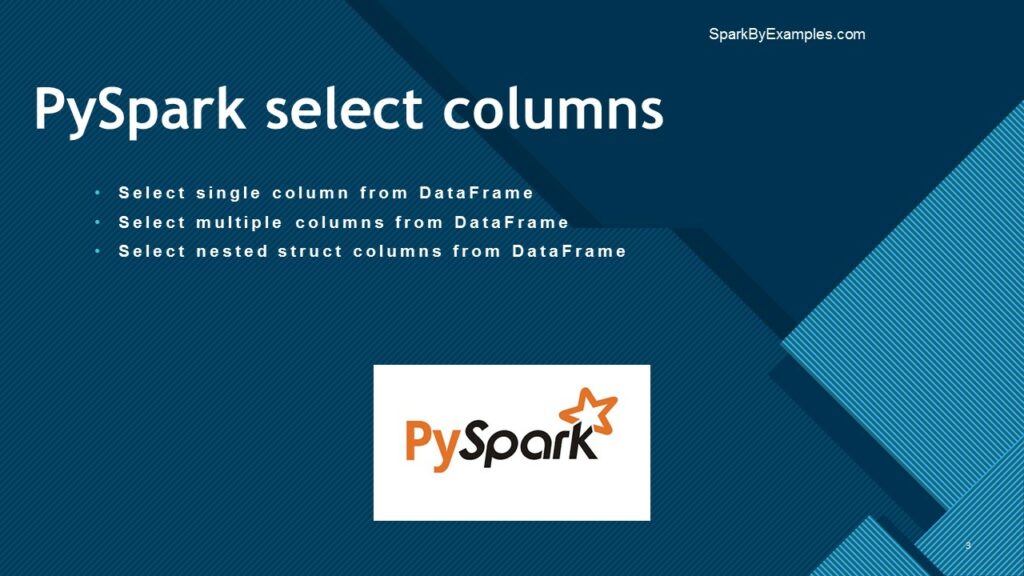In PySpark, select() function is used to select single, multiple, column by index, all columns from the list and the nested columns from a DataFrame, PySpark select() is a transformation function hence it returns a new DataFrame with the selected columns.
- Select a Single & Multiple Columns from PySpark
- Select All Columns From List
- Select Columns By Index
- Select a Nested Column
- Other Ways to Select Columns
First, let’s create a Dataframe.
import pyspark
from pyspark.sql import SparkSession
spark = SparkSession.builder.appName('SparkByExamples.com').getOrCreate()
data = [("James","Smith","USA","CA"),
("Michael","Rose","USA","NY"),
("Robert","Williams","USA","CA"),
("Maria","Jones","USA","FL")
]
columns = ["firstname","lastname","country","state"]
df = spark.createDataFrame(data = data, schema = columns)
df.show(truncate=False)
1. Select Single & Multiple Columns From PySpark
You can select the single or multiple columns of the DataFrame by passing the column names you wanted to select to the select() function. Since DataFrame is immutable, this creates a new DataFrame with selected columns. show() function is used to show the Dataframe contents.
Below are ways to select single, multiple or all columns.
df.select("firstname","lastname").show()
df.select(df.firstname,df.lastname).show()
df.select(df["firstname"],df["lastname"]).show()
#By using col() function
from pyspark.sql.functions import col
df.select(col("firstname"),col("lastname")).show()
#Select columns by regular expression
df.select(df.colRegex("`^.*name*`")).show()
2. Select All Columns From List
Sometimes you may need to select all DataFrame columns from a Python list. In the below example, we have all columns in the columns list object.
# Select All columns from List
df.select(*columns).show()
# Select All columns
df.select([col for col in df.columns]).show()
df.select("*").show()
3. Select Columns by Index
Using a python list features, you can select the columns by index.
#Selects first 3 columns and top 3 rows
df.select(df.columns[:3]).show(3)
#Selects columns 2 to 4 and top 3 rows
df.select(df.columns[2:4]).show(3)
4. Select Nested Struct Columns from PySpark
If you have a nested struct (StructType) column on PySpark DataFrame, you need to use an explicit column qualifier in order to select. If you are new to PySpark and you have not learned StructType yet, I would recommend skipping the rest of the section or first Understand PySpark StructType before you proceed.
First, let’s create a new DataFrame with a struct type.
data = [
(("James",None,"Smith"),"OH","M"),
(("Anna","Rose",""),"NY","F"),
(("Julia","","Williams"),"OH","F"),
(("Maria","Anne","Jones"),"NY","M"),
(("Jen","Mary","Brown"),"NY","M"),
(("Mike","Mary","Williams"),"OH","M")
]
from pyspark.sql.types import StructType,StructField, StringType
schema = StructType([
StructField('name', StructType([
StructField('firstname', StringType(), True),
StructField('middlename', StringType(), True),
StructField('lastname', StringType(), True)
])),
StructField('state', StringType(), True),
StructField('gender', StringType(), True)
])
df2 = spark.createDataFrame(data = data, schema = schema)
df2.printSchema()
df2.show(truncate=False) # shows all columns
Yields below schema output. If you notice the column name is a struct type which consists of columns firstname, middlename, lastname.
root
|-- name: struct (nullable = true)
| |-- firstname: string (nullable = true)
| |-- middlename: string (nullable = true)
| |-- lastname: string (nullable = true)
|-- state: string (nullable = true)
|-- gender: string (nullable = true)
+----------------------+-----+------+
|name |state|gender|
+----------------------+-----+------+
|[James,, Smith] |OH |M |
|[Anna, Rose, ] |NY |F |
|[Julia, , Williams] |OH |F |
|[Maria, Anne, Jones] |NY |M |
|[Jen, Mary, Brown] |NY |M |
|[Mike, Mary, Williams]|OH |M |
+----------------------+-----+------+
Now, let’s select struct column.
df2.select("name").show(truncate=False)
This returns struct column name as is.
+----------------------+
|name |
+----------------------+
|[James,, Smith] |
|[Anna, Rose, ] |
|[Julia, , Williams] |
|[Maria, Anne, Jones] |
|[Jen, Mary, Brown] |
|[Mike, Mary, Williams]|
+----------------------+
In order to select the specific column from a nested struct, you need to explicitly qualify the nested struct column name.
df2.select("name.firstname","name.lastname").show(truncate=False)
This outputs firstname and lastname from the name struct column.
+---------+--------+
|firstname|lastname|
+---------+--------+
|James |Smith |
|Anna | |
|Julia |Williams|
|Maria |Jones |
|Jen |Brown |
|Mike |Williams|
+---------+--------+
In order to get all columns from struct column.
df2.select("name.*").show(truncate=False)
This yields below output.
+---------+----------+--------+
|firstname|middlename|lastname|
+---------+----------+--------+
|James |null |Smith |
|Anna |Rose | |
|Julia | |Williams|
|Maria |Anne |Jones |
|Jen |Mary |Brown |
|Mike |Mary |Williams|
+---------+----------+--------+
5. Complete Example
import pyspark
from pyspark.sql import SparkSession
spark = SparkSession.builder.appName('SparkByExamples.com').getOrCreate()
data = [("James","Smith","USA","CA"),
("Michael","Rose","USA","NY"),
("Robert","Williams","USA","CA"),
("Maria","Jones","USA","FL")
]
columns = ["firstname","lastname","country","state"]
df = spark.createDataFrame(data = data, schema = columns)
df.show(truncate=False)
df.select("firstname").show()
df.select("firstname","lastname").show()
#Using Dataframe object name
df.select(df.firstname,df.lastname).show()
# Using col function
from pyspark.sql.functions import col
df.select(col("firstname"),col("lastname")).show()
data = [(("James",None,"Smith"),"OH","M"),
(("Anna","Rose",""),"NY","F"),
(("Julia","","Williams"),"OH","F"),
(("Maria","Anne","Jones"),"NY","M"),
(("Jen","Mary","Brown"),"NY","M"),
(("Mike","Mary","Williams"),"OH","M")
]
from pyspark.sql.types import StructType,StructField, StringType
schema = StructType([
StructField('name', StructType([
StructField('firstname', StringType(), True),
StructField('middlename', StringType(), True),
StructField('lastname', StringType(), True)
])),
StructField('state', StringType(), True),
StructField('gender', StringType(), True)
])
df2 = spark.createDataFrame(data = data, schema = schema)
df2.printSchema()
df2.show(truncate=False) # shows all columns
df2.select("name").show(truncate=False)
df2.select("name.firstname","name.lastname").show(truncate=False)
df2.select("name.*").show(truncate=False)
This example is also available at PySpark github project.
6. Conclusion
In this article, you have learned select() is a transformation function of the DataFrame and is used to select single, multiple columns, select all columns from the list, select by index, and finally select nested struct columns, you have also learned how to select nested elements from the DataFrame.
Related Articles
- How to Replace Column Values in PySpark DataFrame
- How to Retrieve DataType & Column Names of PySpark DataFrame
- Pyspark Select Distinct Rows
- PySpark Select Top N Rows From Each Group
- PySpark Replace Empty Value With None/null on DataFrame
- PySpark Groupby on Multiple Columns
- PySpark alias() Column & DataFrame Examples
Happy Learning !!
